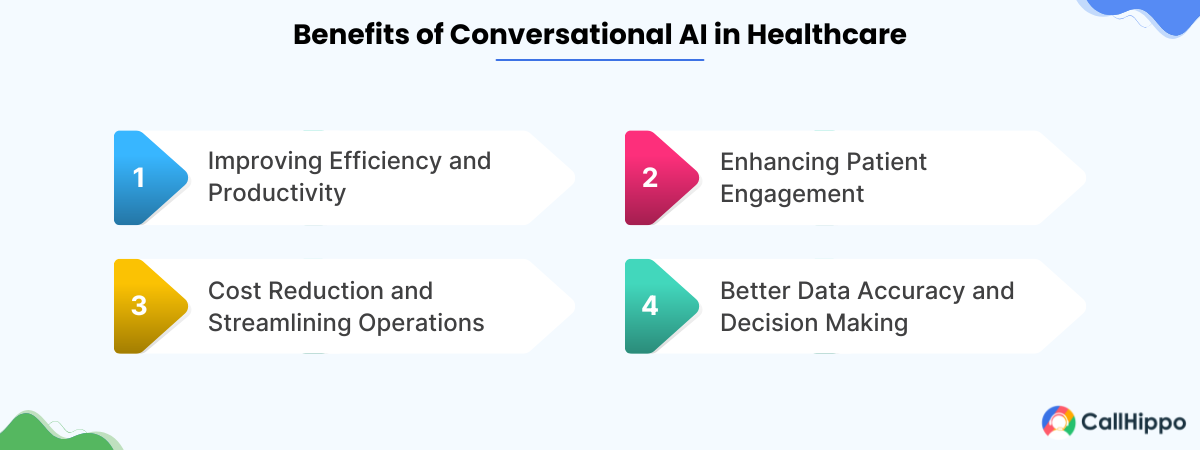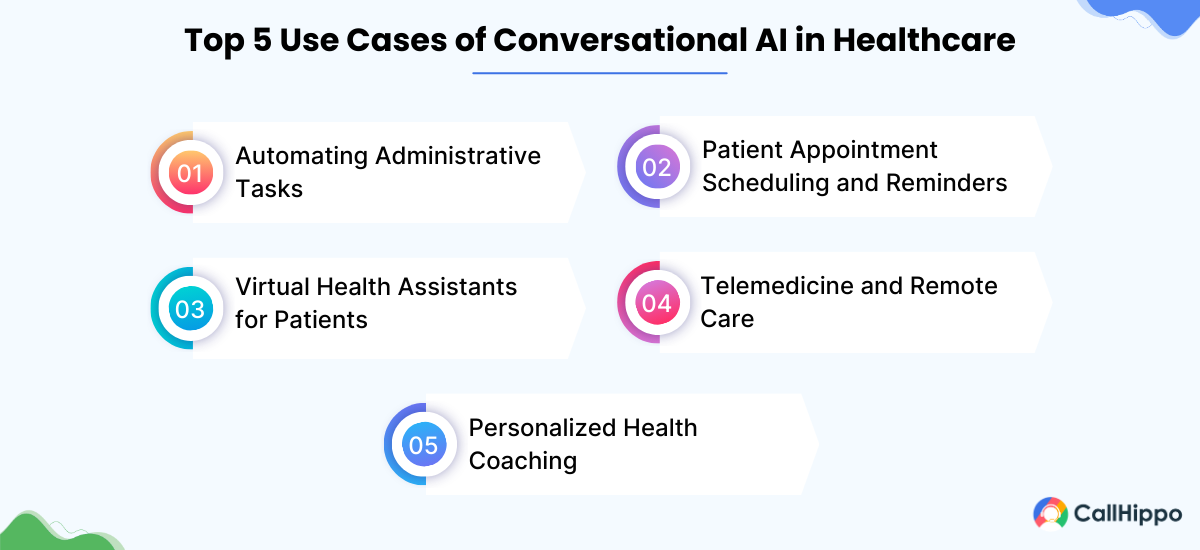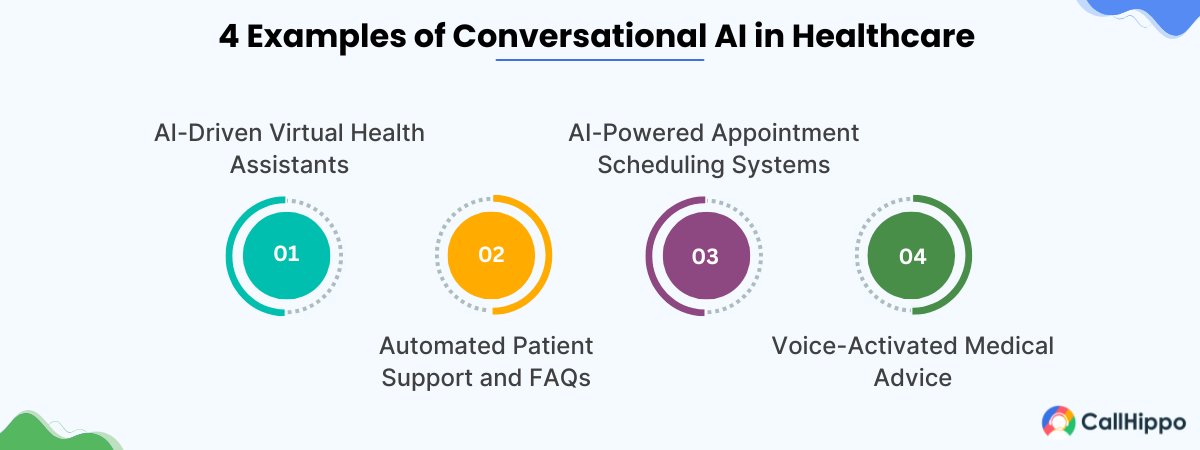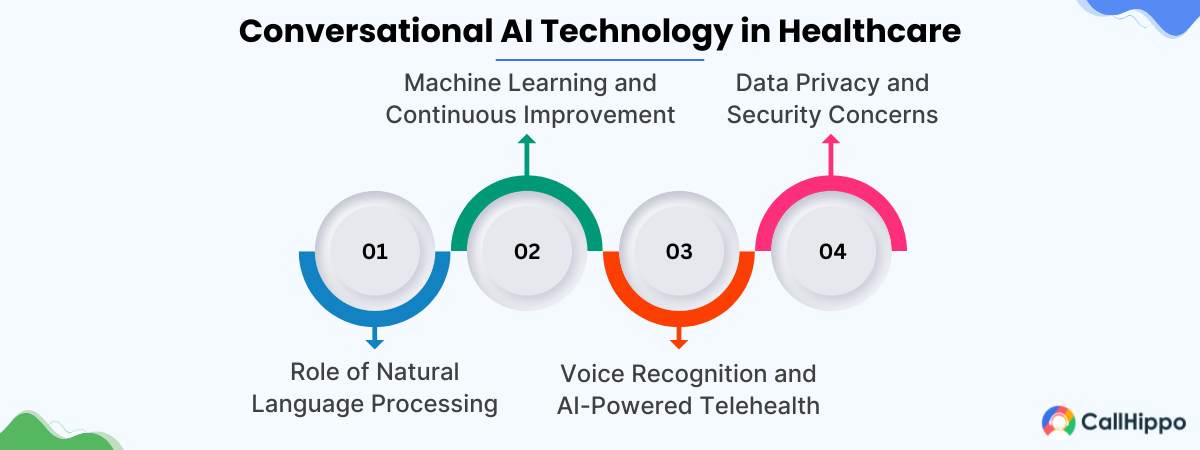How Conversational AI is Revolutionizing Healthcare: An Exciting Overview
Conversational AI in healthcare refers to intelligent systems that can interact with patients using natural language to support various medical tasks such as appointment booking, answering health questions, and providing 24/7 virtual assistance. Unlike basic chatbots, conversational AI understands context, manages follow-up queries, and integrates with healthcare workflows to boost efficiency.
How is conversational AI technology is used in healthcare?
- NLP helps AI understand and respond to human language.
- Machine Learning lets AI improve through experience.
- Voice Recognition allows patients to speak naturally.
- Data Privacy protects sensitive health information.
Healthcare is undergoing rapid change at an unprecedented rate. Long waits, slow replies, and limited doctor access are common issues. But now, conversational AI in healthcare is helping clinics and hospitals manage things better. It enables patients to interact with systems that understand basic needs, such as booking appointments or asking simple health-related questions.
It’s not here to replace doctors but to support them. In this blog, we’ll explain what it is, how it’s used, and why it matters in today’s healthcare world.
What is Conversational AI in Healthcare?
Conversational AI in healthcare involves utilizing intelligent technology for patient interactions, addressing their questions, and guiding them through their healthcare needs, much like a human assistant. It helps doctors, nurses, and staff save time, and gives patients faster responses.
In 2022, the global market for chatbots used in treatment and mental health support was estimated to be worth USD 0.99 billion. By 2032, it is expected to have grown to over USD 6.51 billion at a compound annual growth rate (CAGR) of 21.3% due to rising demand for easily available healthcare services.
Conversational AI refers to computer programs that can understand and respond to human language. In healthcare, this means the system can talk to patients using simple, natural words.
It can answer common questions like “What are the symptoms of a cold?” or “How do I book an appointment?” It can also guide patients step-by-step through tasks like filling out forms or checking their medical reports. The goal is to make the interaction feel smooth and helpful, just like speaking to a trained assistant.
Many top hospitals like the Mayo Clinic and Cleveland Clinic have begun integrating conversational AI into patient-facing health systems to improve patient experience.
As a healthcare tech consultant, I’ve seen conversational AI boost patient engagement and streamline workflows. Start small, use HIPAA-compliant tools, and track performance. Choose platforms built for healthcare—generic bots miss the mark. Treat AI as a support tool, not a replacement for human care.
How Conversational AI is Different from Simple Chatbots?
Many websites have basic chatbots that give standard answers. They follow fixed rules. If you ask them something outside those rules, they get confused. In contrast, the key differentiator of conversational AI in healthcare is its ability to supports multi-turn conversations that goes beyond fixed replies. It understands the meaning of the question, responds with more flexibility, and even handles follow-up questions naturally.
Smarter Conversations, Healthier Outcomes: The Benefits of Conversational AI in Healthcare
Using smart technology in hospitals and clinics isn’t just about keeping up with trends. It brings real results that help both patients and healthcare providers. Conversational AI in healthcare is changing the way people access care, improving services, and making day-to-day work easier for medical teams. Let’s look at some of the key benefits it brings.

1. Improving Efficiency and Productivity
Hospitals often deal with hundreds of queries each day. Staff members spend a lot of time responding to routine inquiries, such as scheduling appointments or updating test reports. These repetitive operations are completed reliably and swiftly by conversational AI.
CallHippo AI Voice Agent is designed to automate these time-consuming tasks, ensuring quicker response times and freeing up staff to focus on more critical activities.
Watch our dashboard video below to see how it works in action, providing seamless, efficient communication within a healthcare setting.
2. Enhancing Patient Engagement
People feel more involved in their care when they get quick and clear communication. Conversational AI helps patients stay informed and connected throughout their healthcare journey. It can send reminders for medicines, follow up on health progress, or even check if they’re feeling better after treatment.
Engaged patients are proven to have better clinical outcomes and higher satisfaction rates, as documented in a 2022 study by the American Journal of Managed Care.
Since it works around the clock, patients can reach out anytime, even late at night or on weekends. This kind of ongoing support builds trust. Patients feel heard and valued, which encourages them to stay on track with treatment and follow medical advice more closely.
3. Cost Reduction and Streamlining Operations
Running a hospital or clinic entails numerous expenses, ranging from staffing to managing paperwork. Conversational AI reduces some of these expenses by automating regular tasks. For example, instead of hiring extra staff for phone support, the system can answer most questions directly. This cuts down costs without lowering service quality.
4. Better Data Accuracy and Decision Making
Conversational AI doesn’t just talk—it also records and manages information. It helps collect data directly from patients in a clear and structured way. Whether it’s symptom updates, medication routines, or treatment feedback, all this information gets stored safely and in the right format.
Per User/Month
- Automated Meeting Scheduling
- Transfer Call to Human Agent
- Multilingual Support
- Calendar Booking Assistant

How Conversational AI is Transforming Healthcare with These 5 Incredible Use Cases?
Conversational AI in healthcare is not just a concept—it’s already being used in real ways that patients and healthcare providers can see and feel every day. From saving time to supporting care, this smart system is helping across different areas. Below are some of the top ways it’s being put to work.

1. Automating Administrative Tasks
Hospitals and clinics often have large amounts of paperwork to handle—insurance forms, patient registrations, report updates, and more. Conversational AI can automate many of these routine tasks. It helps reduce manual work by collecting patient details, confirming records, and organizing files. This gives staff more time to focus on direct patient care and reduces the likelihood of errors resulting from manual data entry.
2. Patient Appointment Scheduling and Reminders
Booking an appointment might seem simple, but it can take time for both staff and patients—especially when lines are busy. With conversational AI, patients can book, reschedule, or cancel appointments in just a few steps using voice or text. The system is available all day, every day, so no one has to wait for office hours.
3. Virtual Health Assistants for Patients
One of the most helpful uses of conversational ai for healthcare is the creation of virtual assistants. These assistants act like a 24/7 support team, answering health questions, helping with medication instructions, or guiding people through their recovery. Patients often feel more supported knowing they can reach out anytime and get quick help.
4. Telemedicine and Remote Care
Conversational AI healthcare systems play a big role in remote healthcare. They can help prepare patients for virtual visits, gather details before the doctor joins, and even share follow-up steps after the call ends. This saves time during online consultations and ensures doctors have all the information they need.
5. Personalized Health Coaching and Chronic Disease Management
Patients with long-term health conditions like diabetes or high blood pressure need regular support. Healthcare and conversational AI tools are being used to give these patients personalized tips, reminders, and progress checks. The system can track blood sugar levels, remind someone to take their medicine, or suggest daily habits that support better health.
4 Game-Changing Examples of Conversational AI in Healthcare
Many healthcare providers and tech companies are now using conversational AI in real-life situations. These tools are already helping patients and doctors in ways that are simple, useful, and time-saving. Below are a few real examples that show how this technology is working today.

1. AI-Driven Virtual Health Assistants (e.g., Babylon Health)
Babylon Health is a popular example of how virtual assistants can support patients. It uses conversational AI to chat with users, understand their symptoms, and provide helpful medical information. People can describe what they’re feeling in plain language, and the AI responds with possible causes or advice on whether to see a doctor.
Babylon Health is licensed and regulated by healthcare authorities in several countries, providing users with confidence in both the safety and medical accuracy of its services.
It’s not just about quick answers—it’s about giving users confidence in understanding their health. Babylon also helps monitor chronic conditions and can connect users to real doctors for consultations. This makes it easier for people to get the help they need without always visiting a clinic in person.
2. Automated Patient Support and FAQs (e.g., Ada Health)
Ada Health is another great example where AI helps patients figure out what might be wrong. It asks simple questions, just like a doctor might during a visit, and then offers a report with possible conditions.
This is especially useful for people who are unsure whether they should go to the hospital or wait it out. It also answers common questions patients might have—like side effects of medicine or when to seek help. For many, it’s like having a knowledgeable helper ready to talk at any hour.
3. AI-Powered Appointment Scheduling Systems (e.g., Zocdoc)
Zocdoc is known for making appointment booking easier. It uses conversational AI technology in healthcare to let patients schedule visits without phone calls or long wait times. You simply type in the type of doctor you need and your availability, and the system displays matching options in real-time.
This saves time for both patients and clinic staff. By providing reminders, it also helps cut down on missed appointments. Tools like Zocdoc are a clear sign that AI can improve everyday healthcare tasks in simple but powerful ways.
4. Voice-Activated Medical Advice (e.g., Sensely)
Sensely offers a voice-based assistant named “Molly” that guides patients through health checks and symptom reports using speech. It listens, understands, and talks back—making it feel more like talking to a person than typing into a screen.
This kind of healthcare and conversational AI tool is helpful for people who may not be comfortable typing or reading for long periods. It’s also a great option for those who prefer speaking over text, especially older adults or those with limited mobility. Sensely shows how voice technology can make healthcare more human and accessible.
The Role of Conversational AI Technology in Revolutionizing Healthcare
The systems behind conversational AI in healthcare are powered by a mix of smart tools and programs. These technologies are not visible to the eye, but they are what make the entire system run smoothly. Understanding how they work can help us see how they support both patients and doctors.
Let’s break down some of the main technologies that make this possible.

1. Role of Natural Language Processing (NLP)
Natural Language Processing, often called NLP, helps computers understand human language. It allows a system to read or hear what a person says and make sense of it—just like a human would. In healthcare, this means patients can type or speak their questions, and the system can respond in simple, accurate terms.
This is useful for explaining medical conditions, guiding users through steps like scheduling, or answering health-related concerns. Without NLP, these systems wouldn’t be able to communicate in a human-like way.
Top conversational healthcare platforms use medically trained NLP models, such as those developed with clinical ontologies and SNOMED CT, to understand patient intent more accurately.
2. Machine Learning and Continuous Improvement
Machine learning is a method where systems learn from the data they receive. Over time, they improve their understanding and get better at ai answering questions or handling different types of users. In healthcare, this means that the more the system is used, the more it adapts to the specific needs of doctors, patients, and medical teams.
It can learn about new treatments, changing health rules, and other updates without being reprogrammed each time. That’s how it becomes more useful the longer it is in use.
3. Voice Recognition and AI-Powered Telehealth
Conversational AI technology in healthcare often includes voice recognition tools. These tools let patients speak naturally instead of typing. This is helpful for older adults or people who are not comfortable using digital devices. The system listens, understands the words, and responds with helpful guidance.
In telehealth, this makes the experience more personal. Patients can explain symptoms by talking, just like they would in a clinic. Doctors can also use it to record notes or gather information during virtual appointments. This helps make digital visits feel more natural and less robotic.
4. Data Privacy and Security Concerns
When health data is shared with AI systems, it must be protected. Conversations between patients and the AI system often include private medical details. That’s why data privacy is a big part of building trustworthy systems in the conversational AI for healthcare industry.
Strict guidelines must be followed by healthcare practitioners to protect patient data. These consist of access control, safe storage, and encryption. Additionally, patients must to be made aware of the use of their data. Keeping the system safe not only protects users but also builds trust between patients and healthcare centers.
4 Key Challenges in Adopting Conversational AI in Healthcare
Even though conversational AI in healthcare has many benefits, its path to regular use is not without hurdles. Hospitals, clinics, and tech teams face significant challenges when integrating this technology into everyday medical use. These issues are important to understand because they affect how smoothly and safely the systems can run.

Here are some of the main challenges that come up during implementation.
1. Data Privacy and Compliance (HIPAA)
Patient privacy is not only crucial but also mandated by law in the healthcare industry. Strict regulations that protect personal health data, such as the Health Insurance Portability and Accountability Act (HIPAA) in the United States, must be adhered to by systems. When conversational AI tools collect or respond using patient information, they must handle it securely.
2. Integration with Legacy Healthcare Systems
Many hospitals still use old or outdated software systems, also called legacy systems. These are often not built to connect easily with new tools like conversational AI. That makes integration difficult and time-consuming.
3. High Initial Costs and ROI Considerations
Setting up conversational AI isn’t cheap. It includes the cost of software, hardware, staff training, and long-term support. For many healthcare organizations, especially smaller ones, this can be a major concern.
They also need to consider the return on investment (ROI). Will the savings or improvements in care be worth the upfront expense? In some cases, the benefits are clear, like fewer missed appointments or better patient satisfaction. But in others, the financial results may take longer to show. Planning for both short- and long-term returns is key.
4. Availability of Quality Training Data
Conversational AI works best when it has high-quality data to learn from—especially in healthcare, where precision matters. But getting that data is not always easy. It needs to be accurate, up to date, and relevant to the real questions and problems patients face.
The Future of Conversational AI in Healthcare
With continued advancements in technology, the way healthcare is delivered will become even smarter, more personalized, and easier to access. Here are some of the exciting ways conversational AI could shape healthcare in the years to come.
1. AI-Powered Diagnostics and Decision Making
In the future, conversational AI for healthcare could play a key role in diagnosing health conditions and helping doctors make decisions. Using vast amounts of medical data, AI systems will be able to assist in identifying symptoms, suggesting possible diagnoses, and recommending treatment plans.
These systems will work alongside doctors, helping to reduce human error and ensure that no important details are missed. Instead of relying only on doctor’s notes or memory, AI will use the patient’s full medical history, lab results, and even the latest medical research to make smarter suggestions. This could make healthcare faster, more accurate, and more effective.
2. Integration with Internet of Things (IoT) Devices
The conversational AI healthcare of the future will also be able to communicate with IoT devices, like wearable health trackers, smart thermometers, or blood pressure monitors. This means AI systems could receive real-time data from patients at home and offer feedback right away.
3. Voice-Activated Healthcare Assistants
Already popular in many households, voice-activated assistants such as Siri, Alexa, and Google Assistant use AI speech recognition to handle tasks, respond to queries, and control smart home technology. In the future, these assistants will become even more involved in healthcare. People could ask them about symptoms, medication side effects, or treatment advice, and get answers instantly.
Imagine asking a voice assistant to remind you to take your medicine, schedule a doctor’s appointment, or check your latest test results—without ever having to type a single word. This would make managing health easier, especially for people with disabilities or those who have difficulty using traditional devices.
Conclusion
Healthcare is something that affects all of us, and it’s changing in ways we couldn’t imagine a few years ago. Conversational AI in healthcare is one of those changes that’s quietly making things better. It’s helping people get quicker answers, manage appointments, and even understand their health without all the waiting and confusion.

Subscribe to our newsletter & never miss our latest news and promotions.









